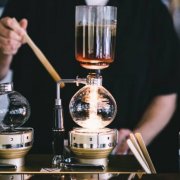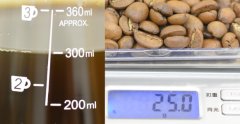The difference between hand-brewed Coffee and Coffee several important brewing conditions of hand-brewed coffee

For professional baristas, please follow the coffee workshop (Wechat official account cafe_style)
No matter which way you use to brew the pot or brew by hand, if you want to make good follicular coffee, you still have to control several important brewing conditions, plus a little experience and curiosity.
Grinding particles
The finer the coffee particles are ground, the total surface area increases, and more ingredients can be dissolved when in contact with water. If you want to make a good cup of hand-brewed coffee, the particles of coffee powder should be larger than that of espresso, and more importantly, the degree of grinding should be uniform: coffee with too fine particles is often overextracted when in contact with hot water.
Dissolve the impurities together, resulting in the bitterness of the coffee and blurring the aroma of the coffee. As for the particle size of the powder, it has to be determined according to the way of hand washing, the amount of cooking (water) and the way of filtration.
The temperature of water
Most of the soluble substances in coffee need high temperature to release, and the best brewing temperature is between 92 and 95 ℃.
Applicable temperature:
Too hot water can burn coffee, and the water temperature is not enough to release aroma molecules, so the water temperature must be determined according to the roasting degree of coffee beans: deep-roasted coffee beans need to lower the water temperature (92 ℃ or less) and light-roasted coffee beans need to increase the water temperature (94-95 ℃).
Gouache ratio of coffee
Follicular coffee is 10 times lighter than espresso, which means that follicular coffee requires less coffee powder and more water. Usually the gouache ratio of follicular coffee is 55-80 grams of coffee to 1 liter of water.
Applicable proportion
Lighter coffee: coffee with a gouache ratio of 55 grams / 1 liter of water.
Slightly stronger coffee: coffee with a gouache ratio of 80 grams per liter of water.
Can increase or reduce the amount of coffee / water, mix out the most suitable gouache ratio.
Extraction time
The contact time between ground coffee powder and hot water determines the amount of soluble substance extracted from coffee solution. Strike a balance between good coffee, leaving as many molecules as we want and filtering out unwanted impurities. If the extraction time is too short, most of the aroma molecules cannot be obtained; if the extraction time is too long, the taste of coffee will deteriorate.
Stir
Stirring coffee with a spoon or stirring stick allows moisture to infiltrate the coffee powder more quickly and comprehensively, while releasing all the molecules of the coffee. Stirring can accelerate the extraction and improve the extraction uniformity, so it can be considered as one of the conditions to enhance the cooking quality, as long as the stirring action should be consistent.
Operation method
If you want to find out the effect of brewing conditions on coffee, it is best to change only one cause at a time, and then compare the results of each brewing.
1. First use the most basic hand-brewing conditions to brew the first cup of coffee, and then change the size of the coffee grinding particles (thicker or finer) to brew the second cup (ideally two cups at the same time). Taste and record the results of the comparison and slowly find out which grinding particles taste best for you.
two。 Use the ground coffee powder that tastes better in the previous step, then change the gouache ratio of the coffee, taste and record the results of the comparison.
3. Using the best gouache ratio, the next one is to change the water temperature of cooking.
The article is extracted from "my Coffee Life proposal" / Sancai Culture
Important Notice :
前街咖啡 FrontStreet Coffee has moved to new addredd:
FrontStreet Coffee Address: 315,Donghua East Road,GuangZhou
Tel:020 38364473
- Prev

The fifth part of the golden cup theory of coffee: the formula for calculating the extraction rate of coffee by immersion brewing.
Professional barista communication please follow the coffee workshop (Wechat official account cafe_style) non-espresso coffee world, we have about two types of brewing: drip method: commonly known as hand brewing, American coffee machine and so on. Immersion method (infusion-immersion method): such as Syphon, French pressure, Philharmonic pressure (AeroPress), Cong
- Next

Hand-brewing parameters: how much water is 15g hand-brewed coffee than water powder?
Professional barista communication please follow the coffee workshop (Wechat official account cafe_style) how to calculate the gouache ratio of hand-brewed coffee? 25 grams of coffee powder, washed out of 300c.c coffee, then the gouache ratio is 12:1 hand coffee gouache ratio how to determine? The same coffee, different water powder ratio, the flavor is completely different. To prepare coffee powder with how much c.c and what concentration you want.
Related
- Beginners will see the "Coffee pull flower" guide!
- What is the difference between ice blog purified milk and ordinary milk coffee?
- Why is the Philippines the largest producer of crops in Liberia?
- For coffee extraction, should the fine powder be retained?
- How does extracted espresso fill pressed powder? How much strength does it take to press the powder?
- How to make jasmine cold extract coffee? Is the jasmine + latte good?
- Will this little toy really make the coffee taste better? How does Lily Drip affect coffee extraction?
- Will the action of slapping the filter cup also affect coffee extraction?
- What's the difference between powder-to-water ratio and powder-to-liquid ratio?
- What is the Ethiopian local species? What does it have to do with Heirloom native species?

